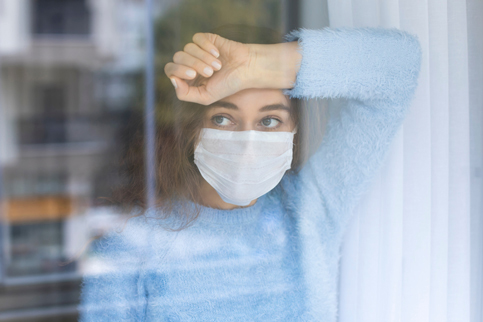The COVID-19 pandemic is taking a heavy toll on our nation’s mental health. Never in living memory have income loss, food and housing insecurity, social isolation, and health anxiety been so simultaneously prevalent on a global scale. And much of the support infrastructure we rely on, such as schools, workplaces, and faith communities, have had to close or reconfigure their typical operations. It’s no wonder that mental health and substance use conditions are on the rise.
A Behavioral Health Crisis
According to multiple surveys, the number of Americans reporting at least one of the following conditions has doubled from 20% to 40% since the start of the pandemic:
- Anxiety
- Depression
- Substance use
- Suicidal ideation
- Stress
- Trauma
What’s more, community mental health metrics worsened steadily across 2020. This downward trajectory was independent of COVID-19 case counts and shows that the pandemic’s length impacts us as much as its severity.
“By leveraging new care delivery models and integrating them across different specialties and departments, we are helping our health system partners make meaningful strides toward mental health parity and improving the lives of our most vulnerable patients.”
Scott Zeller, MD
Vice President of Psychiatry
Behavioral Health Needs Have Increased Pressures on Hospitals
COVID-19 has presented the challenge of a lifetime for healthcare workers. Many of these professionals were experiencing epidemic levels of burnout even before the pandemic. It’s hard to comprehend the impact a year of gowning, masking, infection fears, surges, and public indifference will have on their health and morale.
What’s more, hospital-based teams have been struggling for years to meet patients’ behavioral health needs. Driven by a sharp decline in community-based treatment options, behavioral mental health and substance use-related ED visits increased by 44% between 2006 and 2014. During the same period, the number of visits for suicidal ideation and self-harm more than quadrupled.
Unfortunately, EDs are often ill-equipped to manage behavioral health emergencies. A 2016 ACEP survey found that just 17% of emergency physicians had access to an on-call psychiatrist. And 11% of respondents had no one to consult on mental health and substance abuse cases.
Due to these care gaps, behavioral health patients are admitted at three to four times the rates of all patients. And because psychiatric bed shortages have become endemic in most parts of the country, these individuals wait an average of seven to 34 hours for disposition (depending on the study area).
No New Normal For Mental Health
It’s tempting to believe that our collective mental health will improve after the pandemic passes. However, history suggests this won’t be the case. Seven years after Hurricane Katrina, survivors still showed high rates of psychological distress and post-traumatic stress. Many experts believe that the behavioral health fallout from COVID-19 will be even worse due to the length of the disaster and compounding factors like economic stress, social isolation, and loss of social supports like schools and churches.
The 1918 Spanish flu pandemic may also provide a window into our future. Millions of recovered flu patients continued to struggle with increased mortality and long-term disease sequalae. What’s more, cohorts in utero during the outbreak showed lower educational attainment, higher rates of disability, lower income, and lower socioeconomic status. Their experience suggests that the mental health impacts of COVID-19 may persist for generations.
Another group that will require long-term behavioral health support is the healthcare workforce. For nearly a year, doctors, nurses, advanced providers, first responders, and support staff have been gowning and gloving daily. Many have faced existential threats due to personal protective equipment shortages. Some have separated from their families to protect them from infection. Providers in surge areas like New York and Los Angeles worked long hours in extreme conditions. One New York City emergency physician died by suicide after contracting the disease herself. According to her family, she’d been distressed when patients died in ambulances before they could be brought inside the ED.
A Way Forward with Care Integration
Given these enormous challenges, how can our healthcare system meet the runaway demand for a specialty that is already experiencing acute shortages? I recently co-authored an article focused on the synergies being cultivated between medical care and psychiatric care, and how this is leading to profound benefits for patients and providers alike. This collaborative spirit is embodied in the mission of Vituity and our forward-thinking mindset of leading through change.
Additionally, my recent article in the Psychiatric Times explains how the field of emergency psychiatry has come a long way and leveraging recent advancements will help us meet the growing demands while continuing to rise to the next level. By utilizing new care delivery models and integrating them across different specialties and departments, we are helping our health system partners make meaningful strides toward mental health parity and improving the lives of our most vulnerable patients.
Read more about Vituity’s integrated solutions for behavioral healthcare.























